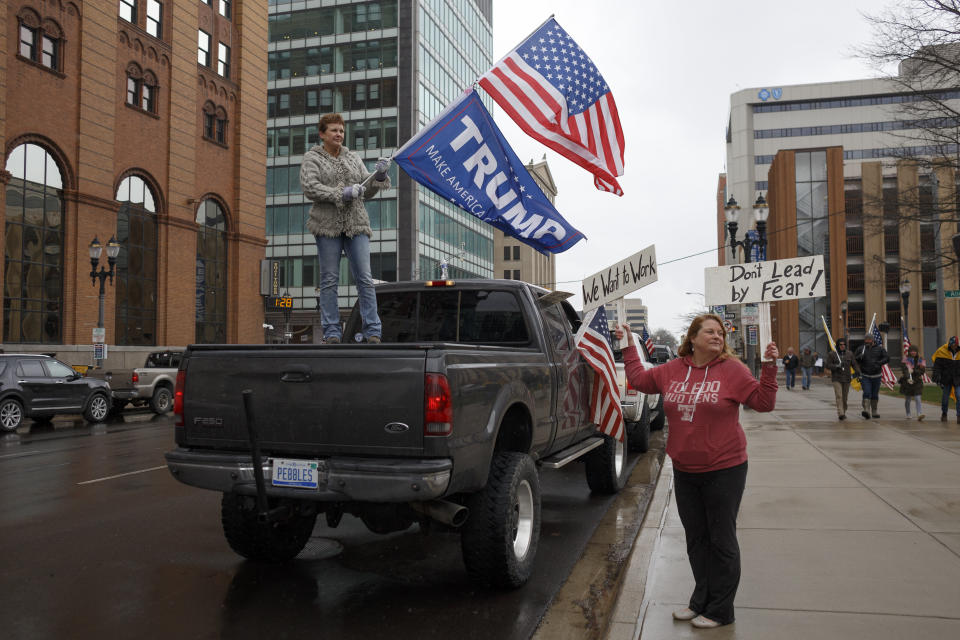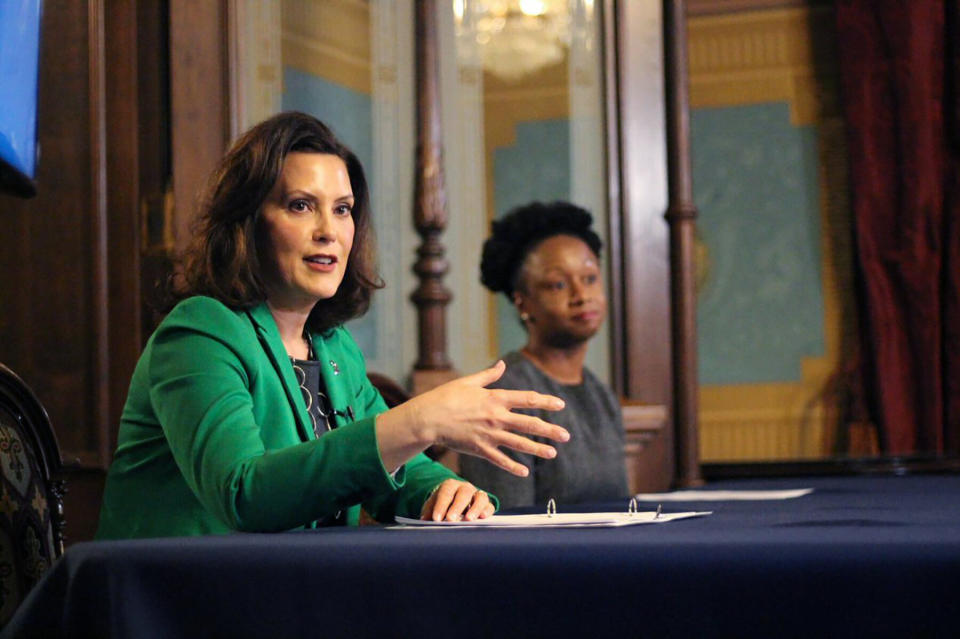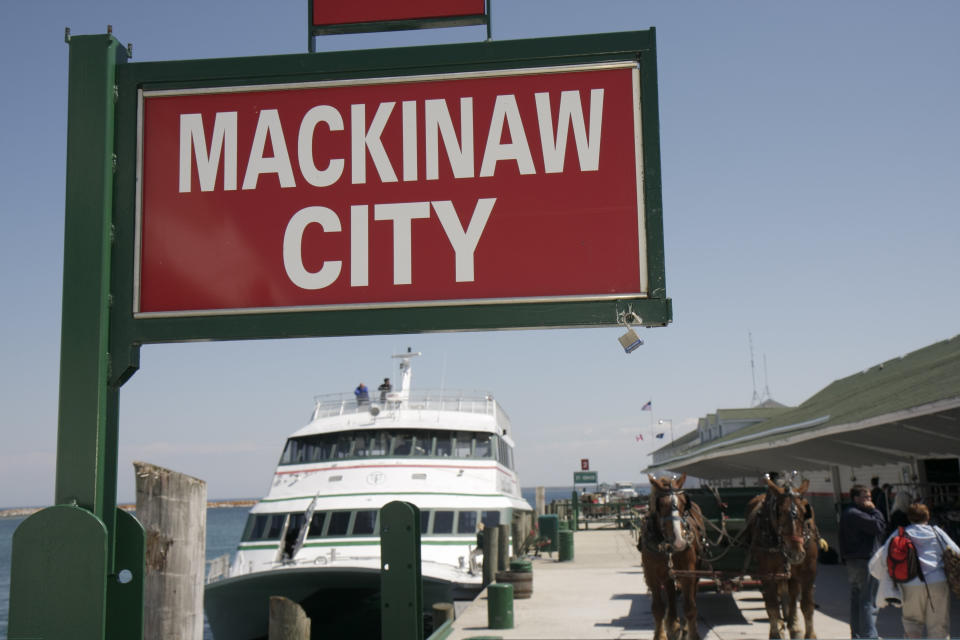Something Big Is Getting Lost In The Debate Over Stay-At-Home Orders
DETROIT ― The patient surge from COVID-19 was just beginning when Gretchen Whitmer, Michigan’s Democratic governor, issued her first stay-at-home order on March 23. Pulmonologist Mahmoud Al-Hadidi, who called me a few days after that, understood better than most why it was necessary.
At his hospital in the northern Detroit suburbs, the caseload of patients with COVID-19, the disease caused by the novel coronavirus, had gone from one to 15 in a week. Workers didn’t have enough protective gear, the ventilator supply was iffy and patients were deteriorating right in front of his eyes.
“Unless you’ve been there, you can’t understand what it’s like,” he said.
And things only got worse from there. At one point, about 70 patients were on ventilators. Even young people were dying, including a 37-year-old medical resident with a wife and three children whom Al-Hadidi knew. He called after that happened, to give another update. “It’s just devastating,” he said.
Then, last weekend, Al-Hadidi texted with a very different sort of message: “Would you like to hear some good news?” The number of patients on ventilators had fallen to just 22. “It’s looking a lot better. And this is what I am hearing from my friends across the state.”
The numbers back that up. COVID-19 has taken a severe toll on Michigan, with more than 2,800 fatalities, but hospitals are now reporting more COVID discharges than admissions, and the number of daily fatalities has been declining. Experts like Joshua Petrie, a University of Michigan epidemiologist, thinks the stay-at-home orders have a lot to do with that.
“Hospitals in southeast Michigan filled close to capacity very quickly, so I think acting quickly and decisively with the stay-at-home order was absolutely necessary,” Petrie, who is part of a team producing predictive models for the governor, told HuffPost on Monday. Frontline health care workers have echoed those sentiments.
But lately, social distancing orders have been a source of controversy. Last week, an estimated 4,000 protesters drove their cars to Lansing, the state capital, clogging streets and demanding that Whitmer dial back the restrictions. Similar demonstrations have since taken place in other states, part of a broader pushback against aggressive social distancing orders.

The campaign has support from conservative financiers, prominent media figures on the right and leaders in the Republican Party ― including, sometimes, President Donald Trump, who for weeks has been agitating to ease social distancing and open up businesses again.
U.S. Attorney General William Barr said in a radio interview on Tuesday that some state orders look “disturbingly close to house arrest” and threatened legal action against governors who go “too far.” Meanwhile, governors in Alabama, Florida, Georgia, South Carolina, Tennessee and Texas have said they are rolling back stay-at-home orders or allowing them to expire before the end of May ― although Georgia’s decision to open businesses like gyms and nail salons on Friday went too far even for Trump, who said on Wednesday that such moves come “too soon.”
The impetus to reopen states quickly flies in the face of advice from most public health experts. It’s also out of sync with public opinion, despite all the hardships that the shutdown has imposed. Only 15% of Americans think coronavirus-related restrictions are excessive, according to a new HuffPost/YouGov survey. Those findings are consistent with other surveys showing the public worries more about opening up too soon than too late.
Polling also shows Americans trust their governors a lot more than they do the president, and that may help explain the recent pushback. Now that the public health crisis has also become an economic one, Trump and his allies may be trying to shift blame onto the governors. Given the polarization in the electorate, it may be only a matter of time before the 30% to 40% of the country that supports Trump decides that he is right about this, too.
But whatever the implications for politics, the story about policy seems clear enough. The very real pain Americans feel likely has a lot more to do with failures at the federal level than anything happening in state capitals. And these failures are taking place in real time, in ways that could extend the nation’s suffering.
The Thinking Behind The Orders
The main grievance against governors like Whitmer is that they have put livelihoods at risk when it wasn’t necessary to save lives. In Michigan, critics have focused their rhetoric on several features of an April 9 order that extended her original directive while adding new restrictions ― including supposed prohibitions on sales of seeds and American flags, but not medical marijuana, as well as a ban on the use of motorboats and travel to vacation homes.
“Today in Michigan, residents can buy marijuana, but they can’t get flowers,” Republican Mike Shirkey, majority leader in the state Senate, wrote in an op-ed for The Bridge. “The list of absurdities in the governor’s order is long, and unlike our gardens, it’s growing.” It was a pretty good riff, though not entirely accurate ― which, perhaps, isn’t so surprising coming from a legislator who, in a speech last year to students at a conservative Christian college, said Whitmer was “on the batshit crazy spectrum.”
Whitmer has not actually banned the sale of seeds or, for that matter, American flags. Rather, she closed nonessential businesses and required that large home improvement outlets, like the Midwest chain Menard’s, cordon off departments like gardening in order to discourage extra foot traffic. “If you’re not buying food or medicine or other essential items, you should not be going to the store,” Whitmer said.
As for the prohibition on motorboating and visiting second residences, a key objective was to prevent interactions that could spread the disease from southeast Michigan to the other parts of the state. As Lisa Peacock, chief health officer at the Northwest Michigan health department, noted in a press briefing on Tuesday, rural hospitals don’t have the capacity to handle a large influx of patients. “Our hospitals operate based on the population that they normally see,” she said.

Reasonable people can question the details of specific restrictions, given their utility and tradeoffs. But Whitmer has said many times that every decision has been difficult ― and that, especially during the weeks when Detroit’s hospitals were at the brink, her priority has been halting the outbreak’s explosive growth.
That has meant paying attention to the scientists, and she’s got a lot of them around her these days. In addition to Chief Medical Officer Joneigh Khaldun and the state’s epidemiologists, as well as those researchers from the University of Michigan, Whitmer has been consulting with four high-profile experts from around the country: Ezekiel Emanuel from the University of Pennsylvania, Scott Gottlieb from the American Enterprise Institute, Ashish Jha from Harvard and Joshua Sharfstein from Johns Hopkins University.
Gottlieb is a conservative, having run the U.S. Food and Drug Administration under Trump for two years. He has also supported aggressive social distancing, as have some Republican governors ― notable among them, Mike DeWine of Ohio, whose actions look a lot like Whitmer’s. Unlike his Michigan counterpart, whom Trump has called “that woman governor” and “half-Whitmer,” DeWine hasn’t incurred the president’s wrath. Perhaps that is because DeWine belongs to the same party as the president.
But DeWine hasn’t escaped the ire of protesters. It was an Ohio demonstration that produced what is now the iconic image of the pushback: A snapshot of some activists standing side-by-side, right up against the Statehouse doors, mouths wide open in mid-shout and nary a protective mask in sight. Conspicuous in the photo, taken by Columbus Dispatch photographer Joshua Bickel, was a red “Trump” hat on one of the men protesting.
The Debate Over The Restrictions
Last week’s Lansing demonstration had a similarly Trumpian flavor, with activists waving pro-Trump signs and chanting “Lock her up” in reference to Whitmer. This was no coincidence. Organizers of the rally included the Michigan Conservative Coalition, a pro-Trump group, and the Michigan Freedom Fund, which has ties to the DeVos family (which, roughly speaking, is to Michigan right-wing politics what the Koch family is to right-wing politics around the country).
The rhetoric is familiar, too, with organizers of the Lansing protests and the activists trying to play up the same divisions between urban and rural populations that Trump does at his rallies. When Vox interviewed Rosanne Ponkowski, president of the Michigan Conservative Coalition, and mentioned the effect of COVID-19 on the Detroit area, Ponkowski said, “Let’s talk about people that live north of Lansing.”
But those people north of Lansing are by no means immune to the virus. Just ask officials in Ostego County, which includes the small city of Gaylord and straddles the state’s main north-south interstate. As of Wednesday, it had 80 confirmed cases, 37 more probable cases and six deaths. Among those who have become ill are at least six paramedics, two of whom were on ventilators as of last week.
Ostego is one of the counties under the jurisdiction of Peacock’s health department, and, during Tuesday’s update for reporters, she stressed the importance of social distancing and the need to maintain it.

“The science is clear that keeping our physical distance is the best tool we have to slow the spread of COVID-19 and to ensure our health care system has the capacity to care for those who need it,” she said. “This is precisely why the actions our residents have taken are so important. And we’re asking people to continue making the sacrifice.”
Shop owners in Mackinaw City may be willing to do that. Mackinaw City is on the northernmost tip of Michigan’s lower peninsula, about 60 miles past Gaylord on the interstate. Business depends on tourists stopping on their way to nearby Mackinac Island or to the Upper Peninsula, so merchants stand to lose plenty of money as the weather warms. But they also have a lot to lose when a virus is on the loose ― and they know it, according to Jamie Westfall, executive director of the Chamber of Commerce.
“We’re afraid when these restrictions are lifted and people are going to come up here,” Westfall told the Detroit Free Press. “What about our employees who live in dorm-style housing? What if our hospitals are overwhelmed? Our No. 1 priority is health. We’re scared.”
The Case For More Government Action
The economic suffering of Michiganders, like the economic suffering of Americans, is real. A million residents in the state were out of work as of last week ― a number that is at once staggering and heartbreaking given the long, difficult recovery after the last downturn, in 2009. Trump has pointed out, correctly, that mental and physical health problems rise during times of economic distress, so that it’s not simply a matter of dollars and cents.
But recovery from this downturn is likely to take time, no matter what decisions Whitmer and other governors make about allowing businesses to reopen. People are unlikely to shop, see movies or attend sports events in large numbers until they are confident they can do so without infecting themselves and others. That cannot happen without a vaccine, effective therapeutics or some kind of herd immunity. In other words, the obstacles are more scientific than political.
Government can help in other ways, however, by providing for people’s needs until the national emergency is over and, separately, by developing enough testing and tracing capacity to isolate outbreaks. Experts say that capacity is an essential prerequisite for reopening because, without it, new outbreaks could lead to new surges. State officials like Whitmer have a big role to play in these efforts, whether by recruiting workers to track down possible exposures or setting up facilities to isolate the sick. On Wednesday, she said her administration was working on precisely those sorts of tasks.
But addressing these needs ultimately requires federal action and, so far, the response from Washington has been lackluster. The Trump administration was slow to take charge of supply lines and, even now, the shambolic distribution of key goods, such as protective gear, has governors arranging secretive shipments on their own. Testing, meanwhile, isn’t nearly at the scale that public health experts say is necessary.
Economic relief also needs to come from Washington because the federal government, unlike states, can borrow at will. Some funds are on the way already. The new COVID-19 bill about to get Trump’s signature will bring the total federal aid in this crisis to something like $3 trillion.
But it’s an open question whether the millions of unemployed Americans and small businesses who are supposed to get aid actually will. Cities and states, whom Democrats proposed to assist, got nothing in that package. Without an infusion, they will be laying off workers rather than hiring the ones they need to manage the crisis better.
And it’s not like they had enough in the first place. The legacy of the decades-long conservative project to “starve the beast” of government are agencies that lack either the personnel or information technology to do their jobs ― which is why state unemployment agencies can’t handle the flood of jobless claims and why state health departments are struggling to compile accurate data.
”We’ve underinvested in public health forever,” said Marianne Udow-Phillips, founding executive director of the Center for Health Research Transformation and Michigan’s former director of health and human services. “It’s going to be a big challenge.”
One other obvious way for the federal government to help would be shoring up the safety net, especially when it comes to providing health insurance while so many people lose job-based benefits. But Trump and his allies have rejected every proposal to make existing government programs more available or to start new ones. It is simply not something they have been willing to contemplate because it violates their core beliefs about the role of government.
The Meaning Of ‘War’
Whitmer’s current order expires on April 30, and she announced Wednesday that she will seek a “short-term” extension. But she has opened the door to easing some restrictions, given the encouraging, if tentative, news that the Detroit area’s patient surge is subsiding. She has also pledged to work with state Republican leaders as she crafts the longer-term plans for reopening state businesses.
But Whitmer has been steadfast in her statements that the threat of the virus remains serious and that saving lives remains her priority. On Monday, Whitmer started her briefing by paying tribute to Skylar Herbert, the 5-year-old daughter of first responders in Detroit who died of a rare COVID-19 complication. “I try to pause to reflect on the lives that have been lost,” she said. “But today’s was especially hard.”
A bit later, after acknowledging the struggles Michiganders face and the rights of protesters to speak out, Whitmer talked about World War II ― how people put up with rationing and served their country in the defense industries. She conjured images of Michigan’s glory days, when it was supplying the arsenal of democracy, then cited the one person who might hold sway with the demonstrators.
“President Trump called this a war ― and it is exactly that,” Whitmer said. “So let’s act like it.”
Love HuffPost? Become a founding member of HuffPost Plus today.
A HuffPost Guide To Coronavirus
Stay up to date with our live blog as we cover the COVID-19 pandemic
What happens if we end social distancing too soon?
What you need to know about face masks right now
How long are asymptomatic carriers contagious?
Lost your job due to coronavirus? Here’s what you need to know.
Everything you need to know about coronavirus and grief
Parenting during the coronavirus crisis?
What coronavirus questions are on your mind right now? We want to help you find answers.
Everyone deserves accurate information about COVID-19. Support journalism without a paywall — and keep it free for everyone — by becoming a HuffPost member today.
This article originally appeared on HuffPost.

